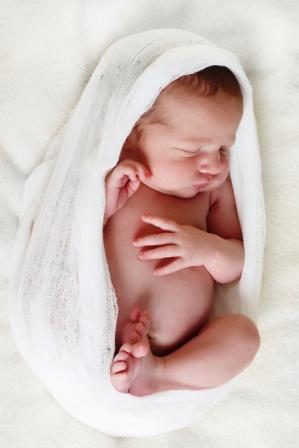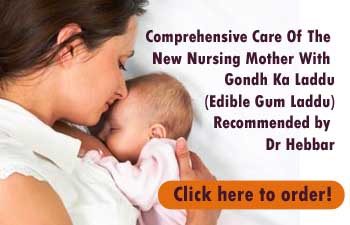Ayurvedic Care Of The Newborn Baby: Jatamatra Paricharya
Article by Dr Raghuram Y.S. MD (Ay) & Dr Manasa, B.A.M.S
There are some immediate measures to be taken soon after the child is born. These measures are called Jaata Karma or Jaatamaatra Paricharya in Ayurveda. Jaatamaatra is the name given to the child who has just arrived into the world, i.e. just born. (Jaata=born, maatra=just).
Jaata Karma includes all those measures which are conducted from immediately after the child comes out of the mother’s womb (birth) up to the cutting of the navel cord or umbilical cord.
Table of Contents
Measures in Jaata Karma
Important measures taken in Jaata Karma
Shareera Shodhana
Shareera Shodhana – cleansing the body.
The body of the child should be cleansed immediately after the child is born. The cleansing of the nose (nostrils), face (mouth), eyes and ears should be given special attention.
अथ खलु जात मात्रम् एव बालम् उल्वात् सैन्धव सर्पिषा मार्जयेत्।(वाग्भट)
Acharya Vagbhata tells ‘Immediately after the birth of the child, the Ulva (secretions or cheesy white coating enveloping the body and face of the new born child) over the body and face should be cleansed by wiping and rubbing it with the mixture of Saindhava Lavana (Rock salt) and Sarpi (ghee)’

अथ जातस्य उल्वम् अपनीय मुखं च सैन्धव सर्पिषा विशोध्य घृताक्तं मूर्ध्नि पिचुं दध्यात्।(सु.शा.१०/१४)
Acharya Sushruta elaborating this procedure advises to separate the Ulva from the body of the new born child and cleanse the face of the child with the combined paste of Sindhava Lavana and Sarpi or ghee processed with saindhava lavana. Later a pichu (sterile cotton swab) dipped in ghee should be placed over the head of the child (crown of the head to be precise).
Ulva or Vernix Caseosa –
Vernix is the waxy or cheese like white substance found coating the skin of the newborn human babies. It is produced by dedicated cells and is thought to have some protective roles during fetal development and for a few hours after birth of the child.
The term Ulva may be commonly used to mention one or all of – the placenta, fetal membranes and vernix caseosa, each of which should be removed from the child and cleansed as first measures immediately after its birth.
The child will try to breathe immediately after its birth. Removal of Ulva will help it breathe easily.
Kantha Vishodhana
Kantha Vishodhana – cleansing the throat and oral cavity:
Soon after the birth, the mouth and throat will be filled or smeared with phlegm. The shleshma needs to be removed and the throat of the child cleansed. Charaka has mentioned the Kantha Shodhana procedure in Jaata Maatra Paricharya.
अथ अस्य तालु ओष्ठ जिह्वा प्रमार्जनम् आरभेत् अङ्गुल्या सुपरिलिखित नखाय सु प्रक्षालित उपधान कार्पास पिचुमत्या।
प्रथमं प्रमार्जितास्य अस्य च अस्य शिर तालु कार्पास पिचुना स्नेह गर्भेण प्रति सञ्च्छादयेत्।
ततो अस्य अनन्तरं सैन्धव उपहितेन सर्पिषा कार्यं प्रच्छर्दनम्।(च.शा.८/४३)
Sterile cotton should be tied to the tip of the finger whose nails have been trimmed. With this finger, the doctor or attendant should cleanse the apalte, lips, throat and tongue.
First of all a cotton swab should be smeared with ghee and placed over the crown of the head of the new born child. Later the child should be given emesis using the mixture of Saindhava Lavana (rock salt) and ghee. This emesis will bring out the deeply stuck phlegm from the throat and stomach. This will make the child breathe easily.
[Now days this procedure is conducted using the catheter. Cleansing of throat and expelling the phlegm is also achieved by holding the child in head low position (holding the child by its foot). The eyes of the child also will be immediately wiped with sterile gauze and cleansed with boric solution; 1-2 drops of Silver Nitrate will be instilled. During the birth, the child’s eyes may be contaminated with vaginal secretions and anal excreta. If these are infected, the child has every possibility of eye disorder called Opthalmia Neonatorum). Eye care is thus essential. Ayurveda too has advised to cleanse the face of the new-born child, which includes the eyes also.]
Prana Vayu Pratyagamana
Prana Vayu Pratyagamana- reviving the respiration.
The child should cry immediately after the birth, which reflects a good breathing mechanism. Sometimes the child doesn’t cry due to the fatigue involved in birth process or the child may be weak enough to cry. In such cases it is thought that the Prana Vayu (vital life element, oxygenation, breath) is stuck or misdirected. Immediate measures should be done to revive the breathing process and make the child cry.
Ayurveda mentions the below said measures in Prana Vayu Pratyagamana –
बला तैलेन परिषेकं कुर्यात्।
कर्ण मूले च अश्मनोः सङ्घट्टनम्।(वाग्भट)
– Bala Taila Parisheka – Bala Taila (medicated oil) should be sprinkled or poured over the body of the new born child
– Ashma Sanghattanam – Two pieces of stones should be taken and should be tapped near the ears of the new born child
Among all the sense organs, the ears of the new born are said to be the first activated ones. The hearing mechanism is directly related with speaking mechanism. Therefore the tapping of stones near the ears can initiate the hearing mechanism. When it is continuously done, the child responds and cries. Thus the prana is resuscitated. Similarly pouring of oil over the body also stimulates the skin and resuscitates the prana, the child thus cries.
If the child is devoid of any activities (inert) and or unconscious, the child should be given ventilation through handmade fans. The below mentioned verse (shloka) should be uttered in the right ear of the new born child as a part of resuscitation process.
अङ्गादङ्गात्सम्भवसि हृदयादभिजायसे ।
आत्मा वै पुत्रनामासि सञ्जीव शरदां शतम् ॥ ३ ॥
शतायुः शतवर्षोऽसि दीर्घमायुरवाप्नुहि ।
नक्षत्राणि दिशो रात्रिरहश्च त्वाभिरक्षतु ॥ ४ ॥
aṅgādaṅgātsambhavasi hṛdayādabhijāyase |
ātmā vai putranāmāsi sañjīva śaradāṃ śatam || 3 ||
śatāyuḥ śatavarṣo’si dīrghamāyuravāpnuhi |
nakṣatrāṇi diśo rātrirahaśca tvābhirakṣatu || 4 ||
Meaning of the verse –
‘You are created and born out of every organ. You are created from the heart. The name of the aatma (soul) is itself Putra (son). You shall live for 100 years. May you be the Shatayu (living for 100 years), one who enjoys the privilege of living for a life span of 100 years or more. Let the stars, directions, night and day always shield you and stand in protecting you.’
To bring the child to consciousness, hot or cold water as suitable to the season may be sprinkled over the face of the new born (i.e. cold water in summer and hot water in winter).
The child may be lightly tapped occasionally.
If the child doesn’t come to consciousness with these maneuvers, one should infer that the child is suffering from respiratory block and intense measures or emergency treatments shall be conducted to bring back the child to consciousness as quickly as possible.
Nabhi Nala Chedana
Nabhi Naala Chedana
Nabhi Naala Chedana means ‘the procedure of cutting the umbilical cord’.
प्रत्यागत प्राणस्य च प्रकृतिभूतस्य नाभि नालं नालाभि बन्धनात् चतुः अङ्गुलस्य ऊर्ध्वं क्षौम सूत्रेण बध्वा तीक्ष्णेन शस्त्रेण वर्धयेत्।
नाभिं च कुष्ठ तैलेन सेचयेत्।(वाग्भट)
When the child comes to consciousness (or is conscious and breathing well) and starts breathing well and when the child starts appearing healthy, the Nabhi Naala or the Umbilical Cord should be cut. Leaving a length of approximately 4 angulas from the nabhi bandhana (root of the umbilical cord wherein it is attached to the child’s navel), the umbilical cord should be ligated with a kshouma sootra (tied with a silk thread) and cut cautiously using a teekshna shastra (sharp instrument, a scalpel). The Nabhi (umbilicus of the child) should be sprinkled with Kushta Taila (oil processed with Saussurea lappa).
ततो नाभि नाडीम् अष्ट अङ्गुलमायस्य सूत्रेण बद्ध्वा च्छेदयेत्, तत् सूत्र एक देशं च कुमारस्य ग्रीवायां सम्यग् बध्नीयात्।(सु.शा.१०/१४)
According to Sushruta, The Nabhi Nadi or umbilical cord should be tied at a distance of 8 angula from the nabhi (navel pit) and should be cut using a sharp instrument proximal (in front or ahead of) the ligature, i.e. away from the place where it has been tied. The free end of the thread should be tied around the neck of the child.
नाभि बन्धनात् प्रभृत्य अष्ट अङ्गुलम् अभिज्ञानं कृत्वा छेदन अवकाशस्य द्वयोः अन्तरयोः शनैः गृहीत्वा तीक्ष्णेन रौक्म राजत अयसानां छेदनानां अन्यतमेन अर्ध धारेण छेदयेत्।ताम् अग्रे सूत्रेण उपनिबन्ध्य कण्ठे अस्य शिथिलम् अवसृजेत्। तस्य चेत् नाभिः पच्येत्, तां लोध्र मधुक प्रियङ्गु सुरदारु हरिद्रा कल्क सिद्धेन तैलेन अभ्यज्यात्, एषां एव तैल औषधानां चूर्णेन अवचूर्णयेत्।(च.शा.८/४४)
Acharya Charaka enumerates it in a detailed way –
The Nabhi Nadi should be measured up to 8 angulas from the Nabhi Bandhana and a mark should be made at that spot. One should tightly hold the nabhi nadi on both sides of the mark or spot chosen to cut. Taking a sharp instrument sharp on one edge (ardha dhara shastra) and made of gold, silver or iron, the umbilical cord should be cut on the pre-selected spot. To the stump of the umbilical cord (nabhi nadi) i.e. the part which is attached (or left over) to the navel a thread is tightly tied to the free end. The free end of the thread is carefully tied to the child’s neck.
If the Nabhi (umbilicus, navel) starts getting suppurated, it should be massaged with the oil prepared with Lodhra (Symplocus racemosa), Yashtimadhu (Indian licorice), Devadaru (Cedrus deodara) and Haridra (turmeric). If the navel has already suppurated, the powder prepared from the same herbs mentioned above (in the preparation of oil) should be dusted.
Care of the nursing mother
In Rural India and in folklore Ayurveda practice, they make a laddu out of dry fruits, called Gondh Ki Laddu or Edible Gum Laddu.
It is administered from 2nd week till 3 – 4 months to improve strength and immunity of the nursing mother.
[Note – The instruments and threads used in these processes shall be properly sterilized. If not, there is a chance of the umbilicus being infected. The infection may spread to the child in quick time and cause septicemia which may cause many complications and may also lead to death.
The stump of the cord attached to the navel usually falls off by 5th day. Sometimes it may not get separated even after 2 weeks. Until the left out part of the umbilical cord dries and falls off, it should be taken care of. Now days the left part is dressed instead of tying a thread and tying the free end of the thread around the baby’s neck. Any one of the Novasulf powder, Gentian violet and Triple dye should be applied over the cut cord. Sterile gauze should be placed over it and bandaged. This will avoid infection and prevent tetanus.]
Just Before Finishing –
Today’s way of ‘immediate care of new born child’ may be sophisticated and much modern but Ayurveda has the oldest documented proofs that they had their own system of taking care of the new born one. This article highlights the ancient procedure of Jaatamaatra Paricharya or Jaatakarma.
Click to Consult Dr Raghuram Y.S. MD (Ayu)










3 comments
S. Eckhardt
dear Dr Raghuram I enjoyed reading your article on Jata matra paricharya. YOu write when newborn is unresponsive a mantra is spoken in the right ear. do you have the name of the mantra? I like to see if I can find a transliteration as I cannot read the sanskrit alphabet. many thanks, S. Eckhardt
Dr J V Hebbar MD(Ayu)Author
Here it is
aṅgādaṅgātsambhavasi hṛdayādabhijāyase |
ātmā vai putranāmāsi sañjīva śaradāṃ śatam || 3 ||
śatāyuḥ śatavarṣo’si dīrghamāyuravāpnuhi |
nakṣatrāṇi diśo rātrirahaśca tvābhirakṣatu || 4 ||
Ute Tipping
That is very kind of you, thank you kindly.